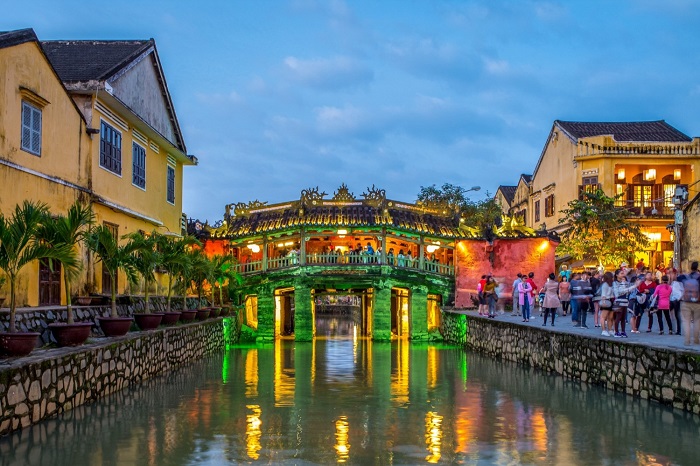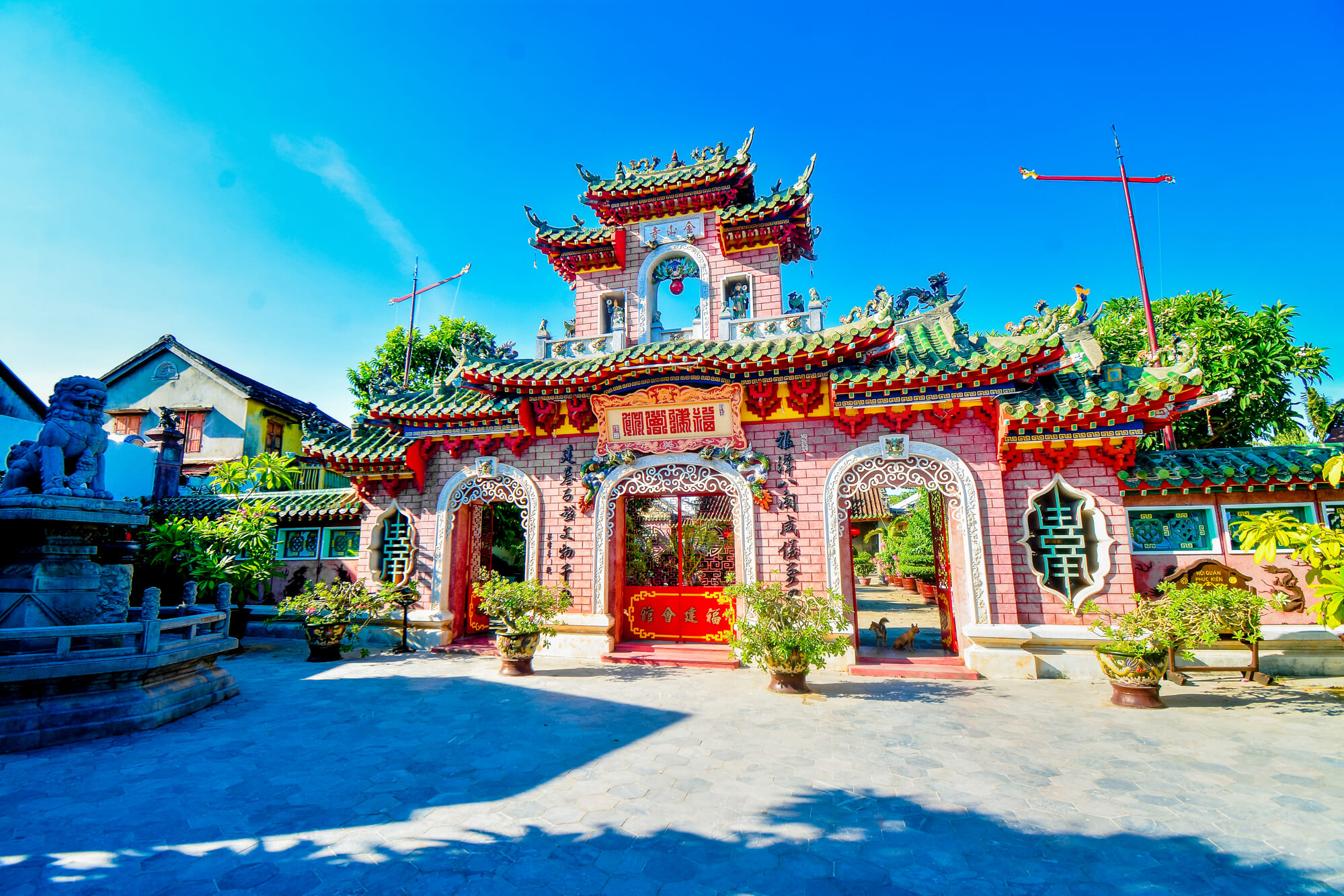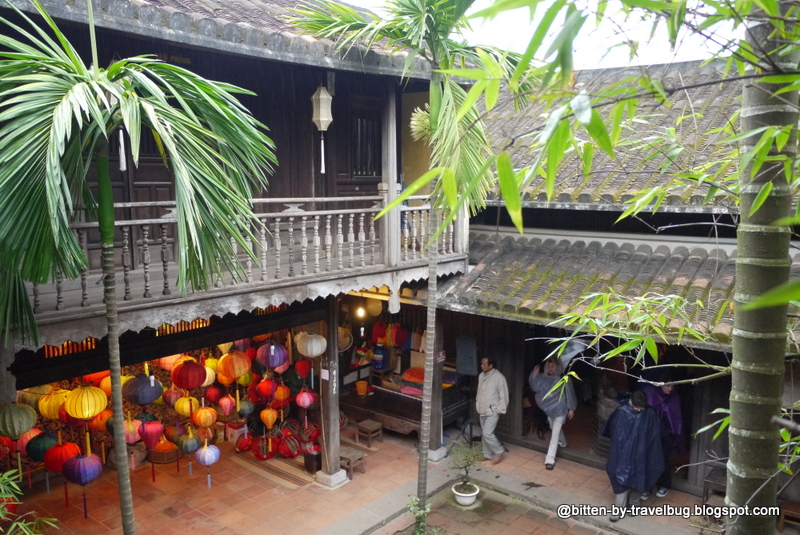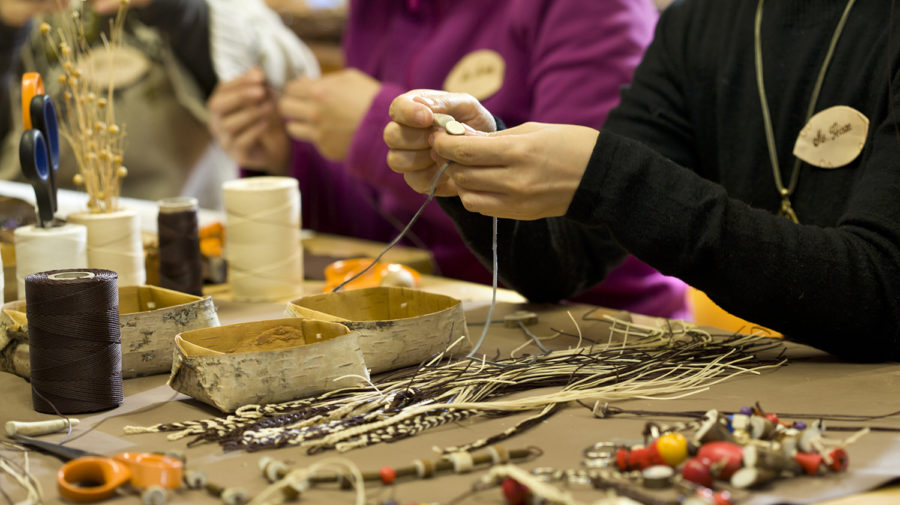There are precious few places where can keep ancient architectures as much as Hoi An Old Town. Visiting to Hoi An Old Town, visitors can enjoy not only classical architectures but also interesting festival held by the local people. There are 8 places in Hoi An tourists should visit when coming to Hoi An Old Town.
1. Bridge pagoda (Japanese – Covered Bridge)
Japanese – Covered Bridge, built in the 1590s by the Japanese, shining like a pearl in the centre of Hoi An. It is a wonderful combination of the style of architecture of Vietnamese, Chinese, Japanese and Westerners. In the 1590s, Japanese came to Hoi An and built Japanese – Covered Bridge for developing their business. In 1637, Japanese left Hoi An, Japanese – Covered Bridge were downgraded, so the people in Hoi An took over it. Then, the king of Vietnam built a temple next to this bridge for worship. The name of this bridge changed from Japanese – Covered Bridge to Bridge pagoda. Japanese also put a monkey statue and a do statue to protect Japanese, Chinese and Vietnamese from monster caused earthquake. In the morning, its walls have pinkish, but when in the evening, they twinkle with many colorful lights.
2. Fujian (Phuc Kien) Assembly Hall
This assembly hall was built by a group of Phuoc Kien people (Chinese) when they came to Hoi An for a living in 1759. Hoi An has 5 assembly halls set up by many Chinese groups but the Fujian hall is the most popular with tourists. A precursor of this assembly hall was a small temple which worshiped Thien Hau – the goddess who recuses sailors from stormy seas. With a lot of restoration and a lot of spiritual festival held by the local people, Fujian assembly hall becomes more splendid and attracts many domestics and foreign travelers every year.
3. Assembly Hall of Chaozhou Chinese Congregation
This assembly hall was built by Chaozhou people (Chinese) to worship general Ma Van – the goddess who can control the stormy seas, help businessmen’s business be in smooth waters. Assembly Hall of Chaozhou Chinese Congregation is prominent with the special architecture and patterns made of wood. It also featured beautiful porcelains which were skillfully made by the ancients.
4. Cantonese Chinese Assembly Hall (Guangdong Assembly Hall)
It is also other assembly hall which established by Chinese. Beautiful granite columns supporting the entrance makes this assembly hall’s architecture become new-fangled. This assembly hall is used for worship general Quan Cong – the talented general of Chinese.
5. Tran family chapel
Tran family chapel, one of the most ancient house in Vietnam, was built around 200 years ago by Tran Tu Nhac – a smart mandarin who lived under the rule of Emperor Gia Long and was very much in the Emperor Gia Long’s confidence. It was built by following “Feng Shui” rules of Vietnamese and Chinese. Tran Tu Nhac built this chapel for everyone of Tran family can together worship their ancestor; it was also a place to help everyone of Tran family get closer to each other every year.
6. Hoi An museum of history and culture
Establish in 1989, this museum displayed 212 original exhibits and documentaries showing the stages of development of Hoi An: the period of Sa Huynh culture (the 2nd century AD); the period of Cham culture (from the 2nd to the fifteenth century) and Dai Viet, Dai Nam culture (from the 15th century to the 19th century).
7. Tan Ky old house
Tan Ky old house, built about 200 years ago, features a special architecture of Hoi An old town, each house was divided into many rooms, each room has a special function. The front of the house was a place that owner can open the store for their business; the back of the house connected with a river for importing and exporting commodities conveniently. These houses were made of traditional material and built by master carpenter.
8. Handicrafts workshop
This workshop has almost all traditional crafts of Hoi An old town and Quang Nam province such as: weave fabric, weave sedge mat, do pottery, do lacquer ware, etc. Travelers can join in some stage of the production process and buy some products for souvenir.
According to reader’s opinion of Condé Nast Traveler (United States) Hoi An ancient town has been voted as the second most favorite tourist destination in Asia after Japan’s Kyoto. This is a good sign showing that Hoi An old town has big steps to develop tourism and has a sustainable position in travelers’ heart.
Vietnam is currently launching a pilot e-Visa system for citizens from 80 countries.
APPLY FOR EVISA NOW=> CLICK HERE!





